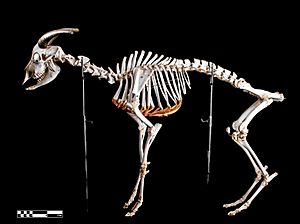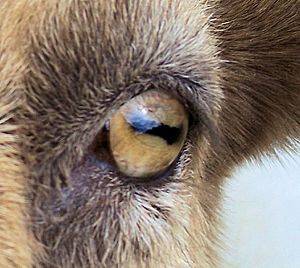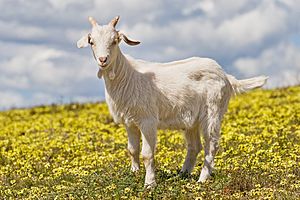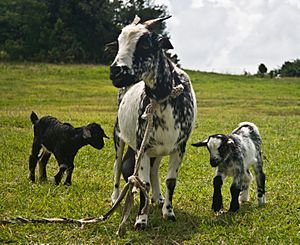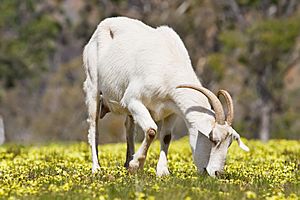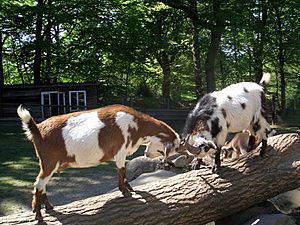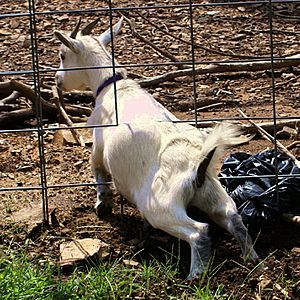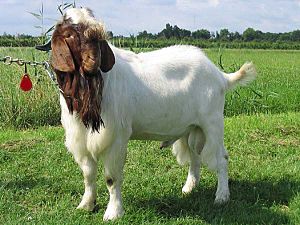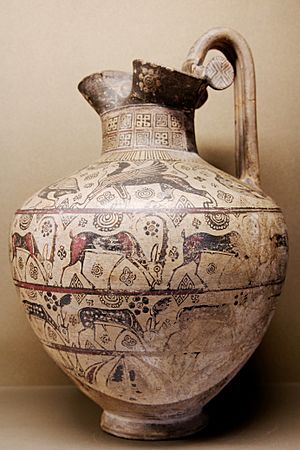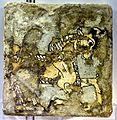Domestic goat facts for kids
The domestic goat (Capra hircus or Capra aegagrus hircus) is a tamed mammal. It comes from the wild goat. A male goat is called a buck, and a female is called a doe. Young goats are called kids.
People use goats for many things. They eat their meat, drink their milk, and use their fur and skin. Goat milk can be made into cheese and other dairy products. Some farmers use goats to eat unwanted plants, called weeds. Goats also help keep grasses and other plants from growing too tall.
Domestic goats have split hooves, a long beard on their chin, a short tail that points up, and horns that curve up from their head. Their hair is straight, with a soft, woolly coat underneath in winter.
Domestic goats are usually about 70-120 cm (28-48 inches) tall. They weigh from 45-54 kg (100-120 lb.).
Goats eat many different plants, including grass, leaves, shrubs, root vegetables, and other greens. Some ranchers use goats to clear unwanted brush from their fields. Goats living in deserts, where plants are hard to find, have even been seen climbing trees to get food!
Domestic goats are smart and active animals. They love to play and climb. They are social animals that live in groups.
Contents
History of Goats
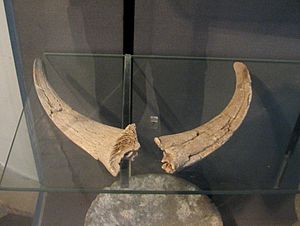
Goats are some of the first animals humans ever tamed. Scientists believe that the wild Bezoar ibex from the Zagros Mountains is the ancestor of most domestic goats today.
Early farmers, about 10,000 years ago, started keeping wild goats. They wanted easy access to milk and meat. They also used goat dung (poop) for fuel, and their bones, hair, and skin for clothes, building, and tools. The oldest signs of tamed goats, dating back 10,000 years, were found in Ganj Dareh in Iran. Goat remains have also been found at old sites in Jericho and other places in Western Asia, showing goats were tamed between 8,000 and 9,000 years ago.
In the past, goat skin was used to make bags for water and wine. It was also used to make parchment, a material for writing.
Goat Anatomy and Health
Goats are considered small livestock animals. They are smaller than cattle or horses, but bigger than chickens or rabbits. Each type of goat breed has its own weight range. For example, large male Boer goats can weigh over 300 lb (136 kg). Smaller breeds, like the African Pygmy, are only about 16 to 23 inches (41 to 58 cm) tall at the shoulder when they are grown.
Most goats naturally have two horns, which come in different shapes and sizes depending on the breed. Some goats are "polled," meaning they are born without horns. Sometimes, horns are removed soon after birth to prevent injuries to people and other goats. Goats' horns are made of living bone covered in a tough material called keratin. They use their horns for defense, to show who is in charge, and to protect their space.
Goats are ruminants, which means they have a special four-chambered stomach. These chambers are called the rumen, the reticulum, the omasum, and the abomasum. Like other ruminants, they have hooves with an even number of toes. Female goats have an udder with two teats, unlike cows which have four. However, Boer goats can sometimes have more teats.
Goats have horizontal, slit-shaped pupils in their eyes. Their eyes often look striking because their irises are usually light-colored, making the dark pupils stand out.
Both male and female goats can have beards. Many types of goats, especially dairy goats, might also have wattles, which are small, fleshy growths that hang from each side of their neck.
Some types of sheep and goats look similar. You can usually tell them apart because goat tails are short and usually point up. Sheep tails hang down and are usually longer and bigger.
Goat Reproduction and Life Cycle
Goats can start having babies when they are between three and 15 months old. Many breeders prefer to wait until the female goat (doe) has reached 70% of her adult weight before breeding her.
In places with changing seasons, goats usually breed when the days get shorter, ending in early spring. In warmer areas near the equator, goats can breed any time of the year, depending on how much food is available. Female goats come into heat (ready to breed) every 21 days for two to 48 hours. A doe in heat often wags her tail a lot, stays close to a male goat (buck), becomes louder, and might eat less or produce less milk.
Male goats (bucks) in cooler climates also get ready to breed in the fall. Bucks in warmer areas can breed all year. When a buck is ready to breed, he might eat less and become very interested in the does. Special scent glands at the base of his horns make him smell strong, which helps attract females.
Besides natural breeding, artificial insemination is also popular. This allows breeders to use many different goat bloodlines.
A goat's pregnancy lasts about 150 days. Usually, a doe gives birth to twins, but single babies or triplets are also common. Sometimes, they can have four, five, or even six kids! Giving birth, called "kidding," usually happens without problems. Just before kidding, the doe's tail and hip area will look sunken, and she will breathe heavily. She might look worried, be restless, and show a lot of affection for her owner. The mother often eats the placenta (afterbirth). This gives her important nutrients and helps stop bleeding. It also helps hide the smell of birth from predators, just like wild plant-eating animals do.
Milk production starts when the doe gives birth. How much milk a goat produces depends on her breed, age, health, and diet. Dairy goats usually produce between 1,500 and 4,000 lb (680 and 1,814 kg) of milk over a ten-month period. A good dairy doe can give at least 6 lb (2.7 kg) of milk per day. After she has been bred again, the doe will usually "dry off," meaning she stops producing milk.
What Goats Eat
Goats are often thought to eat anything, even tin cans! While they won't eat things that aren't food, they are browsing animals, not grazers like cows or sheep. This means they prefer to nibble on the tips of woody shrubs and trees, as well as broad-leaved plants. Because they are very curious, they will chew on and taste almost anything that looks like a plant, including cardboard or paper. The interesting smells of leftover food in cans or boxes might make them even more curious.
Even though they sample many things, goats are quite picky about what they actually swallow. They prefer to eat a very wide variety of plants, including some that are poisonous to other animals. They will rarely eat dirty food or drink contaminated water unless they are starving. This is why goats are often allowed to roam freely, as keeping them in stalls requires a lot of work and is usually not profitable.
Goats prefer to eat vines, shrubbery, and weeds, much like deer do, rather than just grasses. Some plants, like Nightshade, are poisonous to them. Wilted fruit tree leaves can also be deadly. Fermented corn stalks (silage) and fermented grass hay (haylage) can be used as food, but they must be eaten right after opening. Goats are very sensitive to certain bacteria that can grow in fermented feeds. Alfalfa, a plant high in protein, is often fed as hay.
In some parts of China, goats are used to help grow tea. Goats are let loose on tea fields where they avoid eating the bitter green tea leaves. Instead, they eat the weeds. The goats' droppings then fertilize the tea plants.
Young goats (kids) digest milk in a similar way to single-stomached animals. Their first stomach (rumen) is not fully developed at birth. But as the kid starts eating solid food, the rumen quickly grows and learns to absorb nutrients.
How big a goat grows depends on its breed (its natural potential) and its diet while growing (how much nutrition it gets). Goats that get more protein and enough calories when they are young will grow faster and become larger. Larger goats take longer to reach their full size (36 to 42 months) than smaller goats (18 to 24 months).
Goat Behavior
Goats are naturally curious animals. They are also very agile and known for their ability to climb and balance in tricky places. This makes them the only ruminant that regularly climbs trees. Because they are so agile and curious, they are famous for escaping their pens. They will test fences and enclosures, either on purpose or just by climbing on them. If there's any way to get out, goats will almost always find it! Once a goat learns how to escape, it will do it again and again, and other goats will watch and quickly learn the same trick.
Goats explore anything new or unfamiliar around them mainly with their flexible upper lip and tongue. They nibble at things, and sometimes even eat them.
When goats are together in a group, they don't stick together as closely as sheep do. When they are eating undisturbed, they tend to spread out across the field instead of eating side-by-side like sheep. When female goats are nursing their young, they will leave their kids spread out, rather than grouped together like sheep do. Goats will generally turn and face someone who comes near them, and male goats are more likely to charge or butt at humans than male sheep are.
A study by Queen Mary University of London found that goats try to communicate with people in the same way as pets like dogs and horses. Goats were first tamed over 10,000 years ago. The study showed that goats will look to a human for help when they face a problem they used to be able to solve, but now can't. For example, if a goat could open a box to get a treat, but then the box was turned so it couldn't be opened, the goat would turn and look at the person, move towards them, and then look back at the box. This is a complex way of communicating, similar to what dogs do. Researchers believe that understanding how humans and goats interact better could improve the goats' well-being.
Goat Diseases
While goats are generally strong animals and often don't get much medical care, they can get sick. Some common problems for goats include breathing illnesses like pneumonia, foot rot, internal parasites (worms), and problems related to pregnancy. They can also get sick from eating certain toxic plants.
Goats can get various diseases caused by viruses and bacteria, such as foot-and-mouth disease and pinkeye. They can also pass some diseases to people, like tuberculosis and rabies.
Goat Life Expectancy
Goats usually live between 15 and 18 years. There has been one report of a goat living to be 24 years old!
However, some things can shorten their lives. Problems during birth can lower a female goat's life span to 10 or 11 years. The stress of being ready to breed can lower a male goat's life span to 8 to 10 years.
Goats in Agriculture
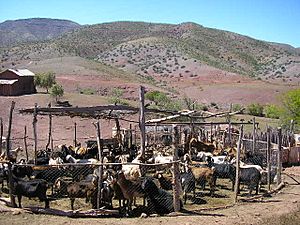
Goats are useful to humans both when they are alive and after they die. When alive, they provide milk, manure (fertilizer), and fiber. After they die, they provide meat and hide (skin). Some charities give goats to people in poor countries because goats are easier and cheaper to care for than cattle, and they have many uses. Goats are also used for pulling carts and carrying packs.
The intestines of goats are used to make "catgut," which is still used for internal human surgical sutures and strings for musical instruments. The goat's horn, which represents plenty and well-being (like the cornucopia), is also used to make spoons.
Goat Population Around the World
In 2008, the top countries producing goat milk were India (4 million metric tons), Bangladesh (2.16 million metric tons), and Sudan (1.47 million metric tons).
How Goats Are Farmed
How goats are cared for and used depends on the region and culture. The type of shelter used for goats depends on their purpose and where they are raised. Historically, domestic goats were often kept in herds that roamed on hills or grazing areas. They were often looked after by goatherds, who were frequently children or teenagers, much like shepherds. These traditional ways of herding are still used today.
In some parts of the world, like Europe and North America, different breeds of goats are kept specifically for dairy (milk) or for meat. Young male goats from dairy breeds are often used for meat. Both male and female goats from meat breeds can be used for meat, as well as older goats of any breed. The meat of older male goats (over one year old) is generally not preferred for human food. If male goats are castrated when young, they won't develop the strong "buck" smell.
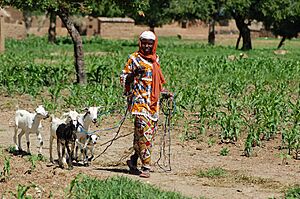
Dairy goats usually graze in pastures in summer and might be kept in barns during winter. Since dairy female goats are milked every day, they are usually kept close to the milking shed. Their grazing is often topped up with hay and special feed. Goats kept in barns might be in individual stalls or larger group pens. In the US, female goats are usually bred every year. In some European dairy farms, female goats are only bred twice and then milked continuously for several years after their second birth.
Meat goats are more often kept in pastures all year round and might be far from barns. Angora and other fiber-producing goats are also kept in pastures or open ranges. Goats kept in pastures or ranges might get extra hay or feed, especially in winter or during dry seasons.
In India, Nepal, and much of Asia, goats are kept mostly for milk production, both on farms and in homes. Goats in these areas might be kept in small enclosures or allowed to roam for food. For example, the Salem Black goat is herded to fields and along roads during the day but kept in a pen at night for safety.
In Africa and the Middle East, goats are often kept in flocks with sheep. This helps make the most of the land, as goats and sheep prefer different plants to eat. In Ethiopia, goats are raised in different ways: pastured in areas with yearly crops, in areas with permanent crops, with cattle, and in dry areas by nomadic herding groups. In all these systems, goats are usually kept in open systems with few purchased supplies. In Nigeria, many families traditionally keep goats. While some goats wander around the home or village, others are kept in pens and fed in a "cut-and-carry" system. This means people cut down grasses, corn, or cane to feed the animals instead of letting the animals into the field. This method is good for feeds that can be easily damaged by trampling.
Some people choose to keep goats as pets in many parts of the world. It's becoming more common for goats to be kept only as pets in North America and Europe.
Goat Meat
The taste of young goat meat is similar to young lamb meat. In fact, in the English-speaking islands of the Caribbean and parts of Asia, the word "mutton" is used for both goat and lamb meat. However, some people compare goat meat to veal (calf meat) or venison (deer meat), depending on the goat's age and condition. Its flavor is mainly linked to certain acids. Goat meat can be cooked in many ways, including stewing, baking, grilling, barbecuing, canning, and frying. It can be minced, made into curry, or turned into sausage. Because it has little fat, the meat can become tough if cooked at high temperatures without adding moisture. One of the most popular goats raised for meat is the South African Boer goat, which came to the United States in the early 1990s. The New Zealand Kiko goat is also a meat breed, as is the myotonic or "fainting goat", a breed from Tennessee.
Goat Milk, Butter, and Cheese
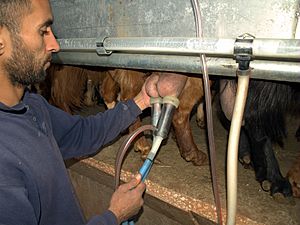
Goats produce about 2% of the world's total milk supply each year. Some goats are bred especially for milk production. If a strong-smelling male goat (buck) is not kept separate from the female goats (does), his scent can affect the taste of the milk.
Goat milk naturally has small fat particles that stay mixed in the milk instead of rising to the top, like cream in raw cow milk. This means it doesn't need to be homogenized. In fact, if the milk is used to make cheese, homogenization is not recommended because it changes the milk's structure, affecting how well it can be made into cheese.
Dairy goats at their best (usually around their third or fourth time giving milk) produce about 6 to 8 lb (2.7 to 3.6 kg) of milk daily. This is roughly 3 to 4 quarts (2.8 to 3.8 liters) over a ten-month period. They produce more milk right after giving birth and gradually less towards the end of their milking period. Goat milk usually has about 3.5% butterfat.
Goat milk is often made into cheese, butter, ice cream, yogurt, and other products. Goat cheese is called fromage de chèvre in France. Some types include Rocamadour and Montrachet. Goat butter is white because goats change the yellow beta-carotene in their milk into a colorless form of vitamin A.
Goat Milk Nutrition
The American Academy of Pediatrics advises against feeding infants milk from goats. A report from April 2010 summarized this advice, stating that feeding babies only plain goat's milk can lead to serious health problems. These problems include issues with body salts, blood problems, allergic reactions, and infections. Untreated goat brucellosis can be dangerous. According to the USDA, goat milk is not recommended for human infants because it does not have enough iron, folate, vitamins C and D, thiamine, niacin, vitamin B6, and pantothenic acid for a baby's needs. It can also harm a baby's kidneys and cause other health issues.
Goat Fiber

The Angora breed of goats produces long, curly, shiny hair called mohair. The entire goat is covered in mohair, and it doesn't have coarse guard hairs. The mohair constantly grows to four inches or more in length. Angora crossbreeds, like the pygora and the nigora, have been created to produce mohair or cashgora on smaller, easier-to-manage animals. The wool is shorn (cut off) twice a year, with an average yield of about 10 lb (4.5 kg).
Most goats have softer, insulating hairs closer to their skin and longer, coarser guard hairs on the surface. The soft hair is valuable for the textile industry and is known by names like down, cashmere, and pashmina. The coarse guard hairs are not very useful because they are too rough, hard to spin, and difficult to dye. The cashmere goat produces a lot of cashmere wool, which is one of the most expensive natural fibers. Cashmere is very fine and soft. Cashmere goat fiber is collected once a year, yielding about 9 oz (255 g) of down.
In South Asia, cashmere is called "pashmina" (from the Persian word for "fine wool"). In the 18th and early 19th centuries, Kashmir had a busy industry making shawls from goat hair brought from Tibet and Tartary. These shawls became popular in Western Europe when a French general sent one to Paris. Because these shawls were made in the upper Kashmir and Ladakh regions, the wool became known as "cashmere."
Goats for Land Clearing
Humans have used goats to clear unwanted plants for centuries. They have been called "eating machines" and "biological control agents." This practice has become popular again in North America since 1990. Herds of goats were used to clear dry brush from California hillsides to help prevent wildfires. This way of using goats to clear land is sometimes called conservation grazing. Since then, many groups have hired private goat herds to do similar jobs. This practice is popular in the Pacific Northwest, where goats are used to remove invasive plants that are hard for humans to get rid of, like thorny blackberry vines and poison oak.
Goats for Medical Training
Because a goat's body is quite similar to a human's, some countries' militaries use goats to train combat medics. In the United States, goats became the main animal used for this purpose after the Pentagon stopped using dogs for medical training in the 1980s. While modern mannequins used in medical training are good at showing how a human body behaves, trainees feel that "the goat exercise provides a sense of urgency that only real life trauma can provide."
Goats as Pets
Some people choose goats as pets because goats can form strong bonds with their human owners. Because goats are herd animals, they will follow their owners around and become very attached to them.
Goat Breeds
Goat breeds fit into different categories that often overlap. They are generally grouped by their main use: for dairy, fiber, meat, skins, or as companion animals. Some breeds are also known for being good pack goats.
Goats in Religion, Mythology, and Folklore
In Norse mythology, the god of thunder, Thor, has a chariot pulled by two goats named Tanngrisnir and Tanngnjóstr. At night, Thor eats the goats' meat but makes sure all their bones stay whole. Then he wraps the remains, and in the morning, the goats come back to life to pull his chariot. Once, a farmer's son broke one of the goat's leg bones to suck the marrow. The next morning, the goat's leg was still broken, and the boy had to serve Thor to make up for the damage.
The Yule goat is an old Scandinavian and Northern European Yule and Christmas symbol. It originally referred to a goat sacrificed around Yule, but it can also mean a goat figure made of straw. It's also part of a tradition where people go door-to-door singing carols and receive food and drinks. The Gävle goat is a giant version of the Yule Goat, built every year in the Swedish city of Gävle.
The Greek god Pan is said to have the upper body of a man and the horns and lower body of a goat. Pan was a very playful god, and many myths about him involve him chasing nymphs. He is also credited with creating the pan flute.
The goat is one of the twelve animals in the Chinese zodiac, which is linked to the Chinese calendar. Each animal is connected to certain personality traits. People born in a year of the goat are thought to be shy, quiet, creative, and perfectionists.
Several mythical creatures are believed to be part goat, including the Chimera. The Capricorn sign in the Western zodiac is usually shown as a goat with a fish's tail. Fauns and satyrs are mythical creatures that are part goat and part human. The element bromine is named from the Greek word "brόmos," which means "stench of he-goats."
Goats are mentioned many times in the Bible. A goat is considered a "clean" animal by Jewish dietary laws and was killed for honored guests. It was also acceptable for some types of sacrifices. Curtains made of goat hair were used in the tent that held the tabernacle (Exodus 25:4). Its horns can be used instead of sheep's horns to make a shofar (a musical instrument). On Yom Kippur, the Day of Atonement, two goats were chosen. One was sacrificed, and the other was allowed to escape into the wilderness, symbolically carrying away the community's sins. This is where the word "scapegoat" comes from. A leader or king was sometimes compared to a male goat leading the flock. In the New Testament, Jesus told a parable about the Sheep and the Goats (Gospel of Matthew 25).
In popular Christian folk tradition in Europe, Satan was often linked to goat imagery. The common medieval picture of the Devil was a goat-like face with horns and a small beard (a goatee). The Black Mass, a possibly mythical "Satanic mass," was said to involve a black goat, which was supposedly the form Satan took for worship.
The goat has had a lasting connection with Satanism and pagan religions, even today. The inverted pentagram, a symbol used in Satanism, is said to look like a goat's head. The "Baphomet of Mendes" refers to a satanic goat-like figure from 19th-century occultism.
The common Russian last name Kozlov means "goat." A Goatee is a style of facial hair on a man's chin, named because it looks a bit like a goat's beard.
Feral Goats
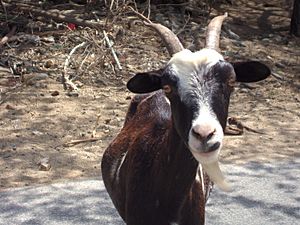
Goats easily return to living in the wild (become feral) if they get the chance. The only other domestic animal known to do this as quickly is the cat. Wild (feral) goats have settled in many places, including Australia, New Zealand, Great Britain, the Galapagos, and many other areas. When there are too many feral goats in places with unlimited water and not enough large predators, or where plants are easily damaged by goats' aggressive eating habits, they can cause serious problems. They might remove native scrub, trees, and other plants that many other creatures need. Feral goats are common in Australia. However, in other situations where predators keep their numbers in check, they can fit into the local food chain.
Images for kids
-
Goats blocking a road in Ladakh
-
A Nigerian Dwarf goat being shown. This female goat is lean and dairy-like, with a large and well-supported udder.
See also
 In Spanish: Cabra doméstica para niños
In Spanish: Cabra doméstica para niños


